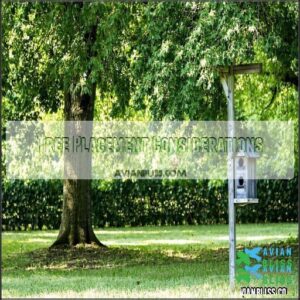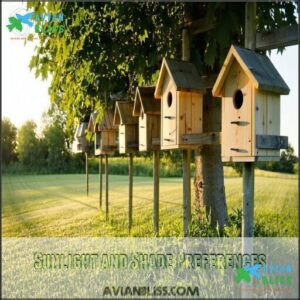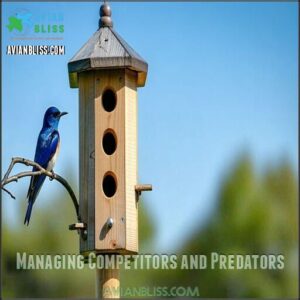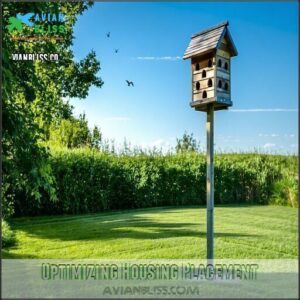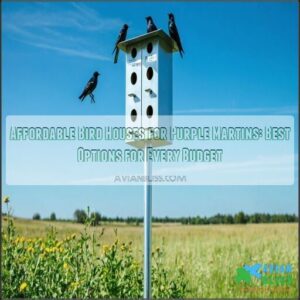This site is supported by our readers. We may earn a commission, at no cost to you, if you purchase through links.
 To attract Purple Martins, start with a sturdy multi-compartment birdhouse or gourd system made from durable materials like aluminum or UV-resistant plastic.
To attract Purple Martins, start with a sturdy multi-compartment birdhouse or gourd system made from durable materials like aluminum or UV-resistant plastic.
Place it in an open area, at least 40 feet away from trees, with plenty of unobstructed flight paths. Position the housing around 10-15 feet high, ensuring it’s between 30-100 feet from human activity since Martins feel safer near people.
Use predator guards to protect nests from invaders like raccoons or snakes. Make sure to clear out non-native competitors like starlings.
Curious about migration timing or precise placement tips? There’s much more to learn—it’s worth the effort to attract Purple Martins and understand their needs, ensuring a successful and safe environment.
Table Of Contents
- Key Takeaways
- Choosing Purple Martin Houses
- Attracting Purple Martins
- Managing Competitors and Predators
- Purple Martin Migration Patterns
- Housing Maintenance and Repair
- Optimizing Housing Placement
- Frequently Asked Questions (FAQs)
- What kind of birdhouse do purple martins like?
- How tall should a Purple Martin birdhouse be?
- What sounds attract purple martins effectively?
- How can weather affect purple martin behavior?
- What native plants benefit purple martins nearby?
- Do purple martins socialize with other bird species?
- How do purple martins communicate during migration?
- How do purple martins choose nesting sites?
- What is the ideal climate for purple martins?
- Do purple martins coexist with other bird species?
- Conclusion
Key Takeaways
- Place birdhouses 12-15 feet high in open spaces at least 40 feet from trees and buildings for clear flight paths and safety.
- Use durable, multi-compartment birdhouses or gourds with predator guards to keep nests protected from raccoons and snakes.
- Clean houses regularly after each nesting season and remove old nests to prevent pests and attract returning martins.
- Install Starling-Resistant Entrance Holes (SREH) and actively control invasive species like starlings and sparrows to give martins a safe place to nest.
Choosing Purple Martin Houses
Selecting the right purple martin house is essential for attracting these birds and ensuring their safety. Choose durable materials, proper dimensions, and easy-to-maintain designs to support their nesting needs.
Selecting durable, well-designed purple martin houses creates a safe, welcoming haven while enhancing your backyard with these graceful, social birds.
Housing Design and Materials
When designing martin houses, focus on durable materials and accommodations that meet purple martins’ preferences.
Here’s a concise guide:
- Use aluminum or natural gourds for material durability.
- Follow proper compartment dimensions — 6×6 inches with 2-1/8 inch entrances.
- Prioritize ventilation to meet ventilation needs.
- Choose white housing for its color impact, reflecting sunlight to stay cool.
Explore practical martin house plans for long-term comfort and safety. Many options are available if you’re looking for martin houses.
Placement Considerations
Choosing the perfect spot for martin house placement is key for success.
Place the housing 12-15 feet high in a large, open area with clear flight paths.
Keep bird housing placement at least 40 feet from trees—25 feet is fine down South—and 30-100 feet from buildings.
Aim it toward the morning sun for prime sunlight exposure.
| Factor | Ideal Distance | Notes |
|---|---|---|
| From Buildings | 30-100 feet | Assures safe, open space |
| From Trees | 40 feet (25 South) | Avoids predator access |
| Housing Height | 12-15 feet | Promotes safe flight |
Attracting Purple Martins
To attract purple martins, place their housing in large, open spaces free from trees or tall structures within 40 feet.
Make certain the site gets morning sunlight, has clear flight paths, and remains safe from predators and invasive species, which is crucial for the purple martins.
Open Space Requirements
To attract purple martins, prioritize open landscapes with plenty of sunlight.
Follow these open space requirements:
- Keep housing 40-60 feet away from obstructions like trees or structures.
- Confirm clear flight paths for easy access.
- Place housing in wide, open areas for safety.
- Avoid crowded locations that block visibility.
Use spaces exposed to sunlight, improving martins’ navigation and comfort. White colored housing aids in temperature control and attracts them effectively.
Tree Placement Considerations
When placing purple martin houses, tree proximity is critical.
Keep a branch distance of at least 40 feet for safety and sunlight access.
In southern regions, 25 feet suffices due to higher martin populations.
Minimize canopy cover for better visibility and easy housing placement.
Protect nests by managing taller trees nearby, as they might invite predators, compromising your martins’ habitat.
Sunlight and Shade Preferences
Purple martin houses need just the right balance of sun and shade to keep nests cool.
Nestlings thrive in the morning sun and midday shade.
For better housing placement:
- Face entrances east for morning sun warmth.
- Provide heat shielding with minimal afternoon exposure.
- Allow proper ventilation to avoid overheating.
This thoughtful placement supports a healthy purple martin habitat, naturally attracting purple martins.
Managing Competitors and Predators
Protecting purple martins means keeping their homes safe from predators and unwanted competitors like starlings and house sparrows.
With proper guards, durable materials, and regular monitoring, you can maintain a secure environment that helps these birds thrive.
Non-Native Competitors
Aggressive competitors like House Sparrows and Starlings often dominate bird housing, leaving Purple Martins displaced.
Use Starling-Resistant Entrance Holes (SREH) and regularly check for unwanted nests—effective Sparrow control methods.
Nest removal and population management are essential, ensuring martins aren’t outcompeted, and these Starling deterrents keep housing safer.
Offering martins a space to thrive without bird housing competition is crucial, making Sparrow control a key aspect of maintaining a healthy environment for them.
Predator Guards and Trays
Protect your purple martins with smart predator guards and trays that stop common threats like raccoons and snakes in their tracks.
Attach effective guards using these tips:
- Guard Materials: Opt for metal shields or durable netting for bird predator protection.
- Tray Design: Use nest trays to catch debris and manage inspections.
- Installation Methods: Secure guards snugly around poles for stability.
- Effectiveness Testing: Check regularly to confirm predators can’t breach defenses.
These systems often require specialized predator guards.
Keep up with maintenance needs for lasting safety.
Starling-Resistant Entrance Holes
Starling-resistant entrance holes (SREH) offer reliable protection for Purple Martins against starlings and house sparrows.
Here’s how to create effective openings:
- Hole Shape: Crescent designs work best to keep starlings out.
- Hole Size: Verify holes are exactly 2 1/8 inches wide.
- Material Durability: Use sturdy materials like aluminum for outdoor longevity.
- Placement: Face holes toward morning sun for better martin acceptance.
- SREH Effectiveness: Smaller holes deter predators while safeguarding nests. You can find a starling resistant entrance online for purchase.
Purple Martin Migration Patterns
Understanding purple martin migration patterns helps you determine the best time to prepare their housing.
These birds travel thousands of miles from South America, arriving in the southern United States as early as January and reaching northern states by late spring, which is crucial for preparing their housing.
Northward Migration Timing
Weather influences play a big role in the migration timing of Purple Martins.
Their journey northward begins in January, with first arrivals marking the season of change.
Migration speed varies, with sunnier regions seeing them earlier.
Here’s a timeline:
| Month | Region Reached |
|---|---|
| January | Southern States |
| February | Gulf Coast |
| March | Southeast USA |
| April | Midwest |
| May | Northern States |
Celebrate their arrival as warmer days approach, and enjoy the warmer days and the Purple Martins!
State-Specific Arrival Dates
Understanding purple martin migration patterns means recognizing how regional variations affect their arrival.
States like Texas and Florida see first arrivals by January, while places like New York and New Hampshire wait until April or May.
These graceful birds follow nature’s rhythm, but climate impact is shifting the calendar.
Citizen scientists track their arrival times, offering insights into changing habits.
Nest boxes can aid conservation efforts.
Watch for them; they’re nature’s signals of spring returning!
Migration Span and Duration
Purple Martin migration spans weeks, covering vast distances from their South American wintering grounds to North America’s breeding sites.
These birds, known for their impressive flight speed, often reach Canada by May.
Migration timing varies across regions, with some arriving as early as January.
Spring also means young scouts searching for next year’s nesting spots, making understanding migration patterns vital for preparing housing and attracting these remarkable travelers becomes essential.
Housing Maintenance and Repair
Keeping your purple martin houses clean and in good repair is essential to guarantee a safe and healthy environment for the birds.
Regularly inspecting for damage, cleaning out old nests, and preparing the housing for winter use can help protect your colony and attract returning martins, which is crucial for maintaining a healthy environment.
Regular Cleaning and Inspection
Keeping your purple martin houses clean guarantees a healthy, inviting space for birds.
Regular bird housing cleaning should include nesting material removal after each season—this prevents pests and illness. During bird housing inspection, check for structural issues like cracks or loose floors.
Regularly clean out old nests to prevent pests and ensure a healthy, inviting space for returning purple martins.
Look for hidden pest infestations and make certain compartments are spotless. Use a 10% bleach solution for disinfection, but rinse thoroughly to avoid residue.
A clean birdhouse can attract new birds. Timing is key—schedule cleanings at the end of the breeding season.
This seasonal martin house maintenance promotes safety, hygiene, and better housing longevity, making your purple martin guests feel right at home.
Damage Repair and Replacement
Over time, material degradation can weaken martin houses, risking their structural integrity.
Conduct thorough inspections to spot cracks, rust, or damaged compartments. Swift component replacement prevents further issues.
Use weatherproofing solutions like rust-resistant hardware and durable paint for longevity. Investing in martin birdhouse kits guarantees compatibility during bird housing repairs.
Regular preventative maintenance helps avoid costly damage repair, keeping your bird house a safe, cozy home for nesting martins year after year.
Winter Storage and Preparation
As winter sets in, give your bird housing a fresh start.
Use a bird housing bleach solution or soapy water for a deep clean.
Let everything air dry before storing.
Plug entrance holes to block unwanted guests like sparrows.
Inspect your housing, repair damages, and check material durability.
Remove old nests, then store in a dry space.
You’ll guarantee spring readiness for purple martins!
Optimizing Housing Placement
To attract purple martins, you’ll need to place their housing in open spaces with clear flight paths and minimal obstructions.
Make certain the house is mounted 12-15 feet high, with plenty of sunlight and at least 40 feet away from trees or buildings, to ensure clear flight paths.
Height and Distance Considerations
When attracting purple martins, getting housing placement right matters.
Follow these five tips for success:
- Set houses at an ideal height of 12–15 feet.
- Keep a tree proximity of 40 feet to guarantee clear flight paths.
- Place houses 30–100 feet from your home for balance.
- Choose open areas with no obstructions.
- Prioritize sunlight exposure while avoiding direct afternoon heat.
Smart placement keeps birds safe and happy!
Pole and Mounting Requirements
A good housing pole is the backbone of bird housing placement.
Go for poles 12-15 feet high for sturdy bird housing placement.
Steel or aluminum mounting materials guarantee durability, while pulley systems simplify maintenance.
To protect against unwanted guests, consider squirrel stopper poles for enhanced security.
Predator baffles stop uninvited pests, and moderate sway tolerance keeps martins safe during storms.
The key considerations for a good housing pole include durability, maintenance, and protection against unwanted guests and predators.
By following these guidelines, you can create a safe and secure environment for birds.
Flight Path and Obstruction Considerations
Make sure your Purple Martin housing sits in open areas with clear flight paths.
Keep at least 40-60 feet of unobstructed views from structures or trees for safe access. Avoid placing houses near dense foliage; open landscapes are the martins’ red carpet.
Focus on proper pole height and consider wind direction to enhance flight safety.
Clear, spacious zones let them glide effortlessly, supporting their aerial agility and reducing risks from obstructions.
Frequently Asked Questions (FAQs)
What kind of birdhouse do purple martins like?
If you were a Purple Martin, you’d demand high-quality housing.
Sturdy, white, multi-compartment houses or gourds, mounted 12-15 feet high in open areas with clear flight paths—plus predator guards to keep uninvited guests out.
How tall should a Purple Martin birdhouse be?
You should mount a Purple Martin birdhouse 12 to 15 feet high.
This height guarantees safety from predators while providing an ideal vantage point.
Choose an open area with clear flight paths for easy access.
What sounds attract purple martins effectively?
Playing the Dawn Song recording at sunrise works wonders to attract purple martins.
It mimics the natural calls made by colonies, signaling safety and community, encouraging them to explore your nesting site.
How can weather affect purple martin behavior?
A sudden cold snap can reduce insect activity by 80%, leaving martins hungry and stressed.
They’ll struggle to feed, so providing supplemental food like crickets during harsh weather can help them survive and thrive.
What native plants benefit purple martins nearby?
Planting cedar elm, catalpa, sumac, or Russian olive trees nearby benefits purple martins.
These provide perching spots and attract insects for food.
Adding flowers like verbena, calendula, or marigolds boosts insect activity around their habitat.
Do purple martins socialize with other bird species?
It’s fascinating—purple martins generally avoid socializing with other bird species.
They’re highly colonial, preferring their own kind. However, they’ll tolerate nearby insect-eating birds that don’t compete for nesting sites, like swallows or flycatchers, and this behavior is a key aspect of their social structure, particularly in relation to colonial living.
How do purple martins communicate during migration?
Purple martins communicate during migration using a mix of chirps, clicks, and whistles.
These sounds help them stay connected in flocks, avoid predators, and coordinate movements, ensuring a safer journey to their breeding or wintering grounds.
How do purple martins choose nesting sites?
Like savvy real estate agents, purple martins pick nesting sites offering safety, open spaces, and sunlight.
They favor multi-compartment birdhouses or gourds, high placement, clear flight paths, and minimal predator threats, ensuring their families thrive.
What is the ideal climate for purple martins?
They thrive in warm, temperate climates with plenty of open space, minimal tree cover, and access to water.
They require abundant flying insects during summers, while winters need to be mild or in their South American range.
Do purple martins coexist with other bird species?
Imagine your backyard with swallows and martins soaring together.
While these birds often coexist peacefully, competition for nests can arise.
Install predator guards and manage invasive species like sparrows to promote harmony among your feathered guests.
Conclusion
Building the perfect bird houses, attracting Purple Martins, and ensuring their safety involves thoughtful placement, durable materials, and active maintenance.
Keep housing in open spaces, elevate it properly, and use predator guards to protect nests.
Clear out aggressive non-native species like starlings, and stay mindful of migration timing to prepare housing early.
By meeting these specific needs, you’ll create a welcoming environment where Purple Martins thrive, adding charm and natural beauty to your outdoor space.




